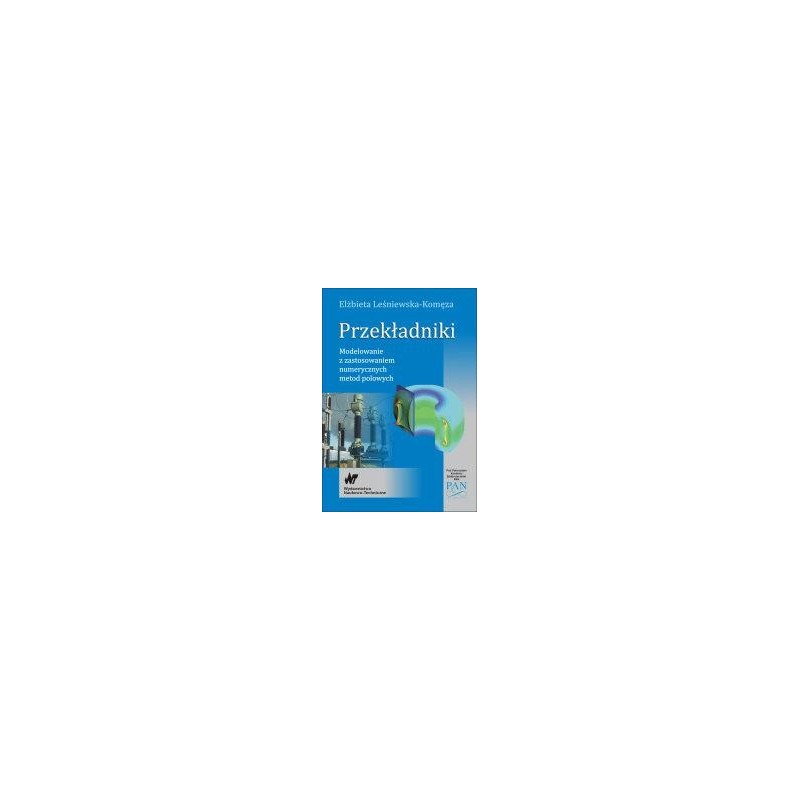- Out-of-Stock



About the book
The book presents the application of field methods for evaluating transformers at the design stage. Numerical methods provide the possibility of more precise calculation of parameters than analytical methods and enable better assessment of the metrological properties of the transformers before the implementation (often very costly) of the prototype and its research. The results obtained by field methods have been experimentally verified on physical models.Table of Contents
PREFACE
LIST OF IMPORTANT MARKINGS
1. INTRODUCTION l
2. ANALYSIS OF ELECTROMAGNETIC FIELDS TRANSFORMERS
2.1. Mathematical basis of modeling of electromagnetic fields
CT
2.2. Creating numerical models of examined objects
2.2.1. Creating two-dimensional models
2.2.2. Creating three-dimensional models
2.3. Calculation of transformer substitute circuit diagram parameters
2.3.1. Calculation of reactance dissipation of transformer winding by field methods.
Voltage transformer with gearbox 15: ^ 3/0, l: VI kV
3. DETERMINATION OF ERRORS OF CURRENT TRANSFORMER
IN CONDITIONAL CONDITIONS ON THE BASIS OF ANALYSIS
The fishing-PERIPHERAL
3.1. Determining the characteristics of current errors and phase shifts
current transformers under rated operating conditions
3.1.1. Laboratory measuring current transformer with core
frame with A / 5A transmission
3.1.2. Current transformer with adjustable gap with 200A / 5A transmission
3.1.3. Protective toroidal through-transformer TPZ class
with a 2400A / 1A transmission
3.1.4. Safety TPZ toroidal transformer
with a 200A / 1A transmission and cores with different number of gaps
3.2. Determination of total current transformer errors
in laying conditions
3.3. Calculation of the peak voltage value with an open circuit
secondary current transformer
4. DETERMINATION OF ERRORS OF CURRENT TRANSFORMER
IN DYNAMIC CONDITIONS
4.1. Determination of the current fault current of the protection transformer
TPZ using the field-peripheral method
4.1.1. Safety TPZ toroidal transformer
with a 600A / 1A gear
4.1.2. Safety TPZ toroidal transformer
with a 2400A / 1A transmission
4.2. Influence of the number and distribution of air gaps in the transformer core
TPZ protection class for transient parameters
4.3. Determination of substitute magnetization characteristics of slotted cores
TPZ class air protection transformers
4.4. Influence of technologies of making air gaps in cores
TPZ class protection transformers for state parameters
transition
5. USE OF THE CALCULATIONS OF THE ELECTRIC FIELD DISTRIBUTION
FOR EVALUATION OF THE CONSTRUCTION OF INSULATION SYSTEMS
RZEKŁADNIKÓW
5.1. Selection of the design version of the high transformer insulation system
and medium voltage
5.11. High voltage voltage transformer with SF6 gas insulation
5.1.2. High voltage voltage transformer with paper and oil insulation
5.1.3. Medium voltage voltage transformer with resin insulation
5.2. Designing main insulation of internal transformers
capacitive control
5.2.1. Way of arranging the electric field control screens in
paper and oil insulation of the main transformers
high voltage
5.2.2. The use of rings at the ends of the screens in isolation
with capacitive control
5.2.3. Designing the high voltage transformer insulation system
combined. Combined transformer with paper and oil insulation from
internal capacitive control
6. INTERNAL ELECTROMAGNETIC COMPATIBILITY
6.1. Influence of mutual coupling of current and voltage parts on
metrological properties of the combined transformer
6.1.1. Coupling by a magnetic field
6.1.2. Coupling through an electric field
6.2. The influence of the mutual location of cores in a multi-core transformer
on the transient parameters of the protection transformer
TPZ class
6 .2.1. Location of mutual cores with slits
6.2.2. The influence of other types of transformers on the TPZ transformer
7. EVALUATION OF THE INFLUENCE OF EXTERNAL FIELDS ON WORK OF TRANSFORMERS
7.1. The influence of the return duct and construction elements on the distribution
the transformer scattering field
7.1.1. A dual-core toroidal through-current transformer
about the 50A / 5A / 5A gearbox
7.1.2. High voltage multi-core current transformer with coil
primary type U with 2kA / lA transmission
7.2. The influence of external fields on the work of transducers
(current-voltage)
7.2.1. Transition current-to-voltage transformer with 40mV / A transmission
BIBLIOGRAPHY.
No product available!
Go far and beyond with the futuristic mini-model of a space conqueror Mars Rover from the Ugears collection of mechanical models.
Spare 30 minutes or so to enjoy the assembly of an ingenious mechanical space vehicle. Inspired by ever-exciting sci-fi and no less amazing recent developments in the space industry, Ugears engineers pay tribute to the final frontier romantics with a six-wheel mechanical space-rover, the Mars Rover. UGears 70165
No product available!
No product available!
No product available!
Xilinx Kintex®-7 XC7K325T-1FFG676 FPGA. 6015-410-001-KIT
No product available!
No product available!
No product available!
No product available!
Green, aluminum case for Raspberry Pi 4 model B. It has been equipped with mounting holes of the VESA 75 standard
No product available!
No product available!
In the continuation of its new Ugears Games series of models dedicated to board games, Ugears proudly presents The Dice Keeper. If you are a dice collector, a passionate gamer, or just fond of unique mechanical devices, The Dice Keeper is exactly what you need. This model will become your favorite accessory to your table top battles as well as a great addition to your collection of wooden 3D puzzles from Ugears Games. UGears 70072
No product available!
Li-Po battery 3.7V / 320mAh, PCM safety, connector + JST-BEC 2,54 socket, 2 pins, cable length 150mm
No product available!
No product available!
Digital ECHO effect for use in audio systems. MK182
No product available!
Assembled LED thermometer - 27mm green version. AVT1697 / 2 / GC
No product available!
Pin strip straight in yellow, single-row, female, 1x10, pitch 2.54mm, THT, RoHS. PB10S YELLOW
No product available!

